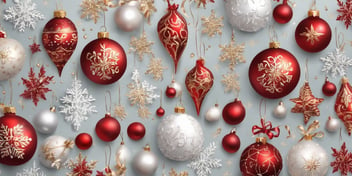- Blog
- Christmas trees
- The History of Christmas Trees: From Ancient Times to the Modern Day

The twinkling lights, the scent of fresh pine, and the joy of decorating – it's that time of year again when Christmas trees take center stage in our homes. But have you ever wondered how this beloved tradition began? Step into a time machine with me as we journey back in time to uncover the fascinating history of Christmas trees, from their humble beginnings in ancient rituals to the iconic symbol of the holiday season we cherish today.
Prepare to be enchanted by the tale of evergreen trees that have stood the test of time and brought warmth and cheer to countless generations.
Definition and Significance of Christmas Trees
Christmas trees garland is a term used to describe the decorative elements that adorn Christmas trees. These garlands are typically made of various materials, such as tinsel, beads, ribbons, or even popcorn. The tradition of using garlands on Christmas trees dates back centuries and has become an integral part of the holiday season.
Christmas trees garland adds a festive and joyful touch to the tree, creating a visually appealing centerpiece for celebrations. It complements the overall theme and decorations, enhancing the beauty and charm of the tree. Whether it's a classic red and green garland or a more modern and eclectic design, the choice of garland allows individuals to personalize their tree and reflect their unique style. It encourages creativity and provides an opportunity for families to come together and decorate their tree, building cherished memories during the holiday season.
Ancient Origins of Christmas Trees
Pagan Traditions and Symbolism
Pagan traditions and symbolism greatly influenced the use of garland on Christmas trees. In ancient Mesopotamia and Egypt, they used greenery and garlands to symbolize life and rebirth during the winter solstice. Roman celebrations of Saturnalia and Sol Invictus featured garlands adorning trees as representations of fertility and abundance. Medieval Europeans incorporated greens onto yule logs and hung garlands to ward off evil spirits.
These pagan customs laid the foundation for the modern-daypractice of draping garland on Christmas trees, adding a touch of nature and festive spirit to the holiday decor.
Ancient Mesopotamia and Egypt
In ancient Mesopotamia and Egypt, the use of garlands in association with trees held symbolic significance and was part of various religious and cultural practices.
- Garlands made of greenery, such as ivy and palm branches, were used to decorate trees during festivals and celebrations.
- These garlands represented fertility, renewal, and the belief in the cycle of life.
- The use of garlands in combination with trees highlighted the connection between nature and spirituality.
- Ancient civilizations recognized the beauty and importance of adorning trees with garlands as a way to honor nature and express gratitude for its abundance.
The tradition of using Christmas trees garland has evolved over time, but the underlying symbolism remains rooted in our ancient beginnings. Today, we continue to decorate trees with garlands to celebrate the joy and beauty of the holiday season, paying homage to the enduring connection between nature and our spiritual beliefs.
Roman Saturnalia and Sol Invictus
During the Roman era, two festivals, Saturnalia and Sol Invictus, played a significant role in the development of Christmas traditions, including the use of Christmas tree garland. Saturnalia, a celebration of the god Saturn, involved exchanging gifts, decorating homes with greenery, and hanging garlands of laurel and holly. Similarly, Sol Invictus, honoring the sun god, involved adorning homes with evergreens and colorful decorations.
These festivals introduced the idea of using garlands to beautify homes during the winter celebrations, a tradition that has since evolved into the use of garlands on Christmas trees today.
Medieval Yule Logs and Greens
During medieval times, Yule logs and greens played a significant role in Christmas celebrations. Yule logs were large, carefully selected logs burned in the hearth to bring luck and ward off evil spirits. They were adorned with evergreen branches, such as holly and ivy, symbolizing eternal life and protection. People believed that these greens would bring warmth and help chase away the darkness of winter.
The use of greens as decorations during this period laid the foundation for the later tradition of Christmas trees garland. Today, many still incorporate evergreen garlands in their Christmas decorations, embracing this ancient tradition of bringing life and vitality into their festive homes.
The Influence of Germany on Modern Christmas Trees
Paradise Trees and Dancing
In the tradition of "Paradise Trees and Dancing," Christmas trees often served as symbolic representations of the Garden of Eden. These trees were adorned with apples, representing the forbidden fruit, and later with other decorations, such as colorful ribbons and festive garland. The act of dancing around the tree during Christmas celebrations was a joyful and communal event, fostering a sense of togetherness and merriment among friends and family.
Today, the spirit of this tradition lives on as people gather around decorated trees, often adorned with beautiful garland, to celebrate the joy and warmth of the holiday season.
The German Reformation and Martin Luther
During the German Reformation in the 16th century, Martin Luther played a significant role in the history of Christmas trees garland. He introduced a new tradition called "paradise trees" as a way to bring the beauty of nature indoors during the Christmas season. These trees were adorned with apples, representing the forbidden fruit from the Garden of Eden. Over time, the apples were replaced with decorative ornaments and garlands made from paper, cloth, or tinsel.
This innovative idea by Martin Luther eventually influenced the modern-day practice of decorating Christmas trees with garlands, adding color and festive charm to the holiday tradition.
Candlelit Trees and Decorations
Candlelit trees have long been a cherished tradition during the holiday season. The warm and flickering glow of candles adds a magical ambiance to the Christmas tree. While safety concerns have led to the replacement of real candles with artificial ones, the charm of candlelit trees still persists. To recreate this enchanting effect, opt for battery-operated LED candles designed specifically for Christmas trees. Adding Christmas tree garland with delicate, reflective accents can further enhance the captivating glow of the candles, creating a festive and cozy atmosphere in your home.
The British Royal Connection
Queen Victoria and Prince Albert
Queen Victoria and Prince Albert played a significant role in popularizing the use of Christmas trees garland during the holiday season.
- Queen Victoria's marriage to Prince Albert, who was of German descent, introduced many German Christmas traditions to Britain, including the use of garlands on Christmas trees.
- The Illustrated London News published a drawing of Queen Victoria, Prince Albert, and their children gathered around a Christmas tree, which increased the popularity of this tradition among the British public.
- The image of the royal Christmas tree set a fashionable trend that quickly spread throughout the country, with many households adorning their trees with garlands made from natural materials like pinecones, berries, and evergreen foliage.
The influence of Queen Victoria and Prince Albert led to the widespread adoption of Christmas tree garlands, making them an integral part of festive decorations during the holiday season.
The Illustrated London News and the Royal Tree
The Illustrated London News, a popular British publication in the mid-19th century, played a significant role in popularizing Christmas trees in England and beyond. In 1848, the magazine featured an illustration of Queen Victoria and Prince Albert's Christmas tree, adorned with beautiful Christmas trees garland, as a symbol of royal holiday celebrations. This influential image caught the public's attention, creating a demand for Christmas trees in households across the country.
The media's portrayal of the royal tree as a lavish and festive centerpiece not only sparked interest but also provided a practical example of how to decorate trees with garlands, inspiring people to replicate the tradition in their own homes.
Popularization of the Christmas Trees
The popularization of Christmas trees greatly contributed to the widespread use of Christmas tree garland. Here are some reasons why the tradition gained traction:
- The Illustrated London News featured a depiction of Queen Victoria and Prince Albert's decorated Christmas tree in 1848, sparking interest and imitation among the public.
- Christmas tree ornamentation became a way for families to showcase their wealth and style, leading to the use of garlands to enhance the visual appeal.
- Advertisements and catalogs began showcasing garland as a must-have decoration, further popularizing its use.
- The influence of media and films in the 20th century continued to promote the use of garland as a staple Christmas tree decoration.
Christmas Trees in America
German Settlers and Their Traditions
- German settlers in America played a significant role in shaping the Christmas tree tradition and the use of garland.
- These settlers brought with them the tradition of decorating trees with edible items such as fruits, nuts, and cookies, which were often hung with colorful ribbons and garlands.
- Garland, made from materials like popcorn, cranberries, or paper, was used to adorn the tree branches, adding a festive touch.
- The German influence spread across communities, and soon, American families began incorporating garland into their own Christmas tree decorations.
- Today, the use of garland on Christmas trees is a widespread tradition, with various styles and materials available, including tinsel, beads, and even handmade garlands created from natural elements like pinecones or dried flowers.
- The German settlers' traditions introduced a touch of creativity and beauty to Christmas tree decorations, which are still admired and celebrated today.
Pennsylvania Dutch Influence
Pennsylvania Dutch influence greatly contributed to the tradition of Christmas tree garland. Influenced by their German heritage, the Pennsylvania Dutch introduced the concept of using edible garlands made from popcorn and cranberries to decorate their trees. This practice spread throughout America and became a popular way to add color and texture to Christmas trees.
Today, many people still enjoy creating their own homemade garlands using various materials like pinecones, ribbons, and even recycled paper. The Pennsylvania Dutch influence on Christmas tree garland showcases the creativity and resourcefulness of their traditions, inspiring us to add a personal touch to our holiday decorations.
The Rockefeller Center Christmas Tree
The Rockefeller Center Christmas Tree, adorned with stunning Christmas trees garland, is an iconic symbol of the holiday season in New York City. Every year, a towering evergreen is carefully selected and decorated with thousands of lights and ornaments. The tree lighting ceremony attracts millions of visitors, fostering a sense of joy and unity. This event has become a cherished tradition, bringing people together to celebrate the spirit of Christmas.
The Rockefeller Center Christmas Tree serves as a reminder of the importance of community and spreading holiday cheer. It inspires individuals to decorate their own trees with beautiful garlands, creating a festive atmosphere in their homes.
Modern Day Christmas Trees
Artificial Trees and Environmental Concerns
Artificial Christmas trees have become increasingly popular due to their convenience and long-term cost savings. However, they also raise environmental concerns. Most artificial trees are made from non-biodegradable materials like PVC, and their production contributes to pollution and greenhouse gas emissions.
Additionally, many people replace their artificial trees every few years, leading to more waste in landfills. As a more environmentally-friendly alternative, consider purchasing a live tree from a local tree farm, which can be later recycled into mulch. If an artificial tree is preferred, opt for those made from eco-friendly materials like recycled PVC or alternative materials like cardboard or wood.
Innovation and Sustainability
Innovation in the realm of Christmas trees garland has led to more sustainable and eco-friendly options. Manufacturers are developing garlands made from recycled materials, such as repurposed fabric or biodegradable materials like jute or hemp.
Additionally, there is a growing trend of garlands adorned with LED lights, which are energy-efficient and long-lasting. Another innovative approach involves incorporating natural elements like dried fruits, pinecones, or cinnamon sticks into garland designs, reducing the reliance on synthetic materials. These sustainable options provide individuals with choices that align with their environmental values while still adding festive cheer to their Christmas tree.
Decorations and Christmas Trees Garland
Decorations play an integral role in enhancing the beauty of Christmas trees, with garland being a popular choice. Christmas tree garland, such as tinsel or bead strands, adds a festive touch and creates a cohesive look. Traditional garlands like popcorn or cranberries offer a rustic charm, while modern options like ribbon or LED light strands bring a contemporary flair. You can coordinate garland colors with other ornaments or choose contrasting shades for visual interest.
Experiment with different textures and lengths to achieve the desired effect. The versatility of garland allows you to customize your tree's appearance and create a unique festive atmosphere.
Popular Garland Styles and Materials
DIY Garland Ideas for Festive Trees
When it comes to DIY garland ideas for festive trees, the possibilities are endless. One popular option is to create a rustic garland using natural materials such as pinecones, dried citrus slices, and twine. For a more glamorous look, consider making a garland with glittery ornaments, beads, and ribbon. Another creative idea is to use paper cutouts or origami shapes to craft a unique garland that adds a personalized touch.
Additionally, don't forget to incorporate elements like cranberries, popcorn, or even small fabric flags to give your garland an extra festive flair. Let your imagination run wild and experiment with different materials and styles to make your Christmas tree truly shine.
Over to you
Christmas trees have a rich history that stretches back to ancient times. In ancient Egypt and Rome, evergreen trees symbolized fertility and rebirth. The tradition of bringing evergreen boughs indoors during the winter months can be traced back to the ancient Druids and Vikings, who believed these trees had magical and protective qualities.
It was not until the 16th century in Germany that the modern tradition of the Christmas tree took shape, when Christians began decorating trees with fruits, nuts, and candles to celebrate the birth of Jesus Christ. The popularity of Christmas trees grew during the Victorian era in England, with Prince Albert, Queen Victoria's husband, popularizing the tradition. Today, Christmas trees are a central part of the holiday season in many countries around the world, with various cultures adding their own unique customs and decorations. The history of the Christmas tree is a testament to the enduring power and symbolism of this beloved holiday tradition.
Read On

Unveiling the Origins of Christmas Trees: A Historical Perspective
It's that time of year again—the air is filled with the scent of pine, colored lights twinkle in...

Uncovering the Fascinating History behind Christmas Tree Traditions
Every year, as the wintery air grows colder and cheerful decorations sparkle in every corner,...

What is the history of the Christmas ornament and its evolution?
As the holiday season approaches, our homes start to twinkle with the magical glow of Christmas...